Detection and Projection of Forest Changes by Using the Markov Chain Model and Cellular Automata
Abstract
:1. Introduction
2. Materials and Methods
2.1. Study Area
2.2. Data Collection
2.3. Data Pre-Processing
2.4. Image Classification
2.5. Spectral Separability
2.6. Classification Accuracy
2.7. Land Use and Land Cover Change Using Markov Chain
2.8. Validation of the Model
2.9. Cellular Automata (CA)
3. Results and Discussion
3.1. Spectral Serability
3.2. Land Use Classification 1973, 1990 and 2014
3.3. Land Use and Land Cover Change (1973–2014)
3.4. Validation of Land use Change Projection
3.5. Land Use Change Projection
4. Conclusions
Acknowledgments
Author Contributions
Conflicts of Interest
References
- Cabrera, V.A.; Vilalta, M.J. Patterns of forest decline and regeneration across scots pine populations. Ecosystems 2013, 16, 323–335. [Google Scholar] [CrossRef]
- Chen, F.C.; Son, T.N.; Chang, B.N.; Chen, R.C.; Chang, Y.L.; Valdez, M.; Centeno, G.; Thompson, A.C.; Aceituno, L.J. Multi-decadal mangrove forest change detection and prediction in Honduras, Central America, with Landsat imagery and a Markov chain model. Remote Sens. 2013, 5, 6408–6426. [Google Scholar] [CrossRef]
- Lambin, F.E.; Meyfroidt, P. Global land use change, economic globalization, and the looming land scarcity. PNAS 2011, 108, 3465–3472. [Google Scholar] [CrossRef] [PubMed]
- Yu, X.J.; Ng, C.N. Spatial and temporal dynamics of urban sprawl along two urban-rural transects A case study of Guangzhou, China. Landsc. Urban Plan. 2007, 79, 96–109. [Google Scholar] [CrossRef]
- Leuzinger, S.; Luo, Y.; Beier, C.; Dieleman, W.; Vicca, S.; Körner, C. Do global change experiments overestimate impacts on terrestrial ecosystems? Trends Ecol. Evol. 2011, 26, 236–241. [Google Scholar] [CrossRef] [PubMed]
- Watson, R.T.; Noble, I.R.; Bolin, B.; Ravindranath, N.H.; Verardo, D.J.; Dokken, D.J. Land Use, Land-Use Change and Forestry: A Special Report of the Intergovernmental Panel on Climate Change, 1st ed.; Cambridge University Press: Cambridge, UK, 2000; p. 388. [Google Scholar]
- Abdalla, M.; Saunders, M.; Hastings, A.; Williams, M.; Smith, P.; Osborne, B.; Lanigan, G.; Jones, M.B. Simulating the impacts of land use in Northwest Europe on Net Ecosystem Exchange (NEE): The role of arable ecosystems, grasslands and forest plantations in climate change mitigation. Sci. Total Environ. 2013, 465, 325–336. [Google Scholar] [CrossRef] [PubMed]
- Dale, V.H. The relationship between land-use change and climate change. Ecol. Appl. 1997, 7, 753–769. [Google Scholar] [CrossRef]
- Villers, R.L.; Trejo, V. Assessment of the vulnerability of forest ecosystem to climate change in Mexico. Clim. Res. 1997, 9, 87–93. [Google Scholar] [CrossRef]
- Mansera, O.; Ordóñez, M.J.; Dirzo, R. Carbon emissions from Mexican forests: Current situation and long-term scenarios. Clim. Change 1997, 35, 265–295. [Google Scholar] [CrossRef]
- Grimm, N.B.; Grove, J.M.; Pickett, S.T.A.; Redman, C.L. Integrated approaches to long-term studies of urban ecological systems. Bioscience 2000, 50, 571–584. [Google Scholar] [CrossRef]
- González, E.M.S.; González, E.M.; Tena, F.A.; González, R.L.; López, E.L. Vegetación de la sierra madre occidental, México: Una síntesis. Acta Bot. Mex. 2012, 100, 351–403. [Google Scholar]
- Potter, S.C. Terrestrial biomass and the effects of deforestation on the global carbon cycle results from a model of primary production using satellite observation. Bioscience 1999, 49, 769–778. [Google Scholar] [CrossRef]
- Manjarrez-Domínguez, C.; Pinedo-Alvarez, A.; Pinedo-Alvarez, C.; Villarreal-Guerrero, F.; Cortes-Palacios, L. Vegetation landscape analysis due to land use changes on arid lands. Pol. J. Ecol. 2015, 63, 272–279. [Google Scholar] [CrossRef]
- Turner, M. Landscape ecology in North America: Past, present and future. Ecology 2005, 86, 1967–1974. [Google Scholar] [CrossRef]
- Bormann, F.H.; Likens, G.E. Pattern and Process in a Forested Ecosystem, 1st ed.; Springer-Verlag: New York, NY, USA, 1994; p. 245. [Google Scholar]
- Kabba, S.T.V.; Li, J. Analysis of land use and land cover changes, and their ecological implications in Wuhan, China. J. Geogr. Geol. 2011, 3, 104–118. [Google Scholar] [CrossRef]
- Pal, M.; Mather, P.M. Assessment of the effectiveness of support vector machines for hyperspectral data. Future Gener. Comput. Syst. 2004, 20, 1215–1225. [Google Scholar] [CrossRef]
- Hansen, M.C.; Loveland, T.R. A review of large are monitoring of land cover change using Landsat data. Remote Sens. Environ. 2012, 122, 66–74. [Google Scholar] [CrossRef]
- Tang, J.; Wang, L.; Zhang, S. Investigating landscape pattern and its dynamics in Daqing, China. Int. J. Remote Sens. 2005, 26, 2259–2280. [Google Scholar] [CrossRef]
- Read, J.M.; Lam, N.S. Spatial methods for characterizing land cover and detecting land-cover changes for the tropics. Int. J. Remote Sens. 2002, 23, 2457–2474. [Google Scholar] [CrossRef]
- Coppin, P.; Jonckheere, I.; Nackaerts, K.; Muys, B.; Lambin, E. Digital change detection methods in ecosystem monitoring: A review. Int. J. Remote Sens. 2004, 25, 1565–1596. [Google Scholar] [CrossRef]
- Bolstad, P.; Lillesand, T.M. Rapid maximum likelihood classification. Photogramm. Eng. Remote Sens. 1991, 57, 67–74. [Google Scholar]
- Franklin, J.; Woodcock, C.E.; Warbington, R. Multi-attribute vegetation maps of forest services lands in California supporting resource management decisions. Photogramm. Eng. Remote. Sens. 2000, 66, 1209–1217. [Google Scholar]
- Mas, J.F.; Flores, J.J. The application of artificial neural networks to the analysis of remotely sensed data. Int. J. Remote Sens. 2008, 29, 617–663. [Google Scholar] [CrossRef]
- Lin, Y.P.; Chu, H.J.; Wu, C.F.; Verburg, P.H. Predictive ability of logistic regression, auto-logistic regression and neural network models in empirical land-use change modeling—A case study. Int. J. Geogr. Inf. Sci. 2011, 25, 65–87. [Google Scholar] [CrossRef] [Green Version]
- Brown, D.G.; Page, S.; Riolo, R.; Zellner, M.; Rand, W. Path dependence and the validation of agent-based spatial models of land use. Int. J. Geogr. Inf. Sci. 2005, 19, 153–174. [Google Scholar]
- Dewan, A.M.; Yamaguchi, Y.; Rahman, M.Z. Dynamics of land use/cover changes and the analysis of landscape fragmentation in Dhaka Metropolitan, Bangladesh. GeoJournal 2012, 77, 315–330. [Google Scholar] [CrossRef]
- Guild, L.; Cohen, W.; Kauffman, J. Detection of deforestation and land conversion in Bondonia, Brazil using change detection techniques. Int. J. Remote Sens. 2004, 25, 731–750. [Google Scholar] [CrossRef]
- Pinedo, A.C.; Pinedo, A.A.; Martinez, Q.R.M. Analysis of deforested areas in the north central region of the Sierra Madre Occidental, Chihuahua, México. Tecnociencia Chihuahua 2007, 1, 36–43. [Google Scholar]
- Yuan, D.; Elvidge, C. NALC land cover change detection pilot study: Washington DC data experiments. Remote Sens. Environ. 1998, 66, 166–178. [Google Scholar] [CrossRef]
- Verhagen, P. Case Studies in Archaeological Predictive Modeling; Amsterdam University Press: Amsterdam, The Netherlands, 2007; p. 224. [Google Scholar]
- Lambin, E.F. Modelling Deforestation Processes: A Review; Office for Official Publications of the European Community: Brussels, Belgium, 1994. [Google Scholar]
- Glenn, D.C.; Lewin, R.K.; Peet, T.T.V. Plant Succession: Theory and Prediction; Chapman & Hall: London, UK, 1992. [Google Scholar]
- Hu, Z.; Lo, C. Modeling urban growth in Atlanta using logistic regression. Comput. Environ. Urban Syst. 2007, 31, 667–688. [Google Scholar] [CrossRef]
- Cabral, P.; Zamyatin, A. Markov Processes in Modeling Land Use and Land Cover Changes in Sintra-Cascais, Portugal. Dyna 2009, 191–198. [Google Scholar]
- Liu, Y. Modelling Urban Development with Geographical Information Systems and Cellular Automata; Taylor & Francis Group: New York, NY, USA, 2009; p. 177. [Google Scholar]
- Lepš, J. Mathematical modelling of ecological succesion–A review. Folia Geobot. Phytotax. 1988, 23, 79–94. [Google Scholar] [CrossRef]
- Arsanjani, J.J.; Kainz, W.; Mousivand, A.J. Tracking dynamic land-use change using spatially explicit Markov Chain based on cellular automata: The case of Tehran. Int. J. Image Data Fusion 2011, 2, 329–345. [Google Scholar] [CrossRef]
- Camacho, O.M.T.; Pontius, R.G., Jr.; Paegelow, M.; Mas, J.F. Comparison of simulation models in terms of quantity and allocation of land chance. Environ. Model. Softw. 2015, 69, 214–221. [Google Scholar] [CrossRef]
- Yang, X.; Zheng, X.-Q.; Lv, L.N. A spatiotemporal model of land use change based on ant colony optimization, Markov chain and cellular automata. Ecol. Model. 2012, 233, 11–19. [Google Scholar] [CrossRef]
- INEGI (Instituto Nacional de Estadística, Geografía e Informática) 2012—Información Nacional, por Entidad Federativa y Municipios. Available online: www.inegi.org.mx/ (accessed on 24 February 2016). (in Spanish).
- Richards, J.A.; Jia, X. Remote Sensing Digital Image Analysis: An Introduction, 4th ed.; Springer-Verlag: Berlin, Germany, 2006; p. 439. [Google Scholar]
- Eastman, J.R.; Van Fossen, M.E.; Solarzano, L.A. Transition Potential Modeling for Land Cover Change. In GIS, Analysis, Spatial, Modeling; Maguire, D.J., Goodchild, M.F., Batty, M., Eds.; ESRI Press: Redlands, CA, USA, 2005; p. 386. [Google Scholar]
- Mitsova, D.; Shuster, W.; Wang, X. A cellular automata model of land cover change to integrate urban growth with open space conservation. Landsc. Urban Plan. 2011, 99, 141–153. [Google Scholar] [CrossRef]
- Bhattacharyya, A. On a measure of divergence between two statistical populations defined by their probability distributions. Bull. Calcutta Math. Soc. 1943, 35, 99–109. [Google Scholar]
- Eastman, R.; Idrisi, T. Guide to GIS and Image Processing, Manual Version 16.02; Clark University: Worcester, MA, USA, 2009; p. 342. [Google Scholar]
- Smits, P.C.; Dellepiane, S.G.; Schowengerdt, R.A. Quality assessment of image classification algorithms for land-cover mapping: A review and a proposal for a cost-based approach. Int. J. Remote Sens. 1999, 20, 1461–1486. [Google Scholar] [CrossRef]
- Congalton, R.G.; Oderwald, R.G.; Mead, R.A. Assessing Landsat classification accuracy using discrete multivariate analysis statistical techniques. Photogramm. Eng. Remote Sens. 1983, 49, 1671–1678. [Google Scholar]
- Mousivand, A.J.; Alimohammadi, S.A.; Shayan, S. A New Approach of Predicting Land Use and Land Cover Changes by Satellite Imagery and Markov chain model (Case study: Tehran). Ph.D. Thesis, Tarbiat Modares University, Tehran, Iran, 2007. [Google Scholar]
- Benenson, I.; Torrens, P.M. Geosimulation: Automata-Based Modeling of Urban Phenomena; Wiley: Chichester, UK, 2004; pp. 1–287. [Google Scholar]
- Strigul, N.; Florescu, I.; Welden, R.A.; Michalczewski, F. Modelling of forest stand dynamics using Markov chains. Environ. Model. Softw. 2012, 31, 64–65. [Google Scholar] [CrossRef]
- Clark Labs. IDRISI Geographic Information Systems and Remote Sensing Software; Clark Labs: Worcester, MA, USA, 2006. [Google Scholar]
- Wolfram, S. Cellular automata as models of complexity. Nature 1984, 311, 419–424. [Google Scholar] [CrossRef]
- Vazquez, Q.G.; Pinedo, A.A.; Manjarrez, D.C.; De Leon, M.G.; Hernandez, R.A. Analysis of temperate forest fragmentation using spatial medium-resolution remote sensing in Pueblo Nuevo, Durango. Tecnociencia Chihuahua 2013, 7, 88–98. [Google Scholar]
- Renteria, A.B.; Treviño, G.E.; Navar, C.J.; Aguirre, C.O.; Silva, C.I. Woody fuel assessment in the ejido Pueblo Nuevo, Durango. Rev. Chapingo 2005, 11, 51–56. [Google Scholar]
- Pompa, G.M.; Zapata, M.M.; Hernandez, D.C.; Rodriguez, T.E. Geospatial model as strategy to prevent forest fires: A case study. J. Environ. Prot. 2012, 3, 1034–1038. [Google Scholar] [CrossRef]
- FAO. Food and Agriculture Organization. State of the World’s Forest. Available online: http://www.fao.org/docrep/016/i3010e/i3010e.pdf (accessed on 24 February 2016 2016).
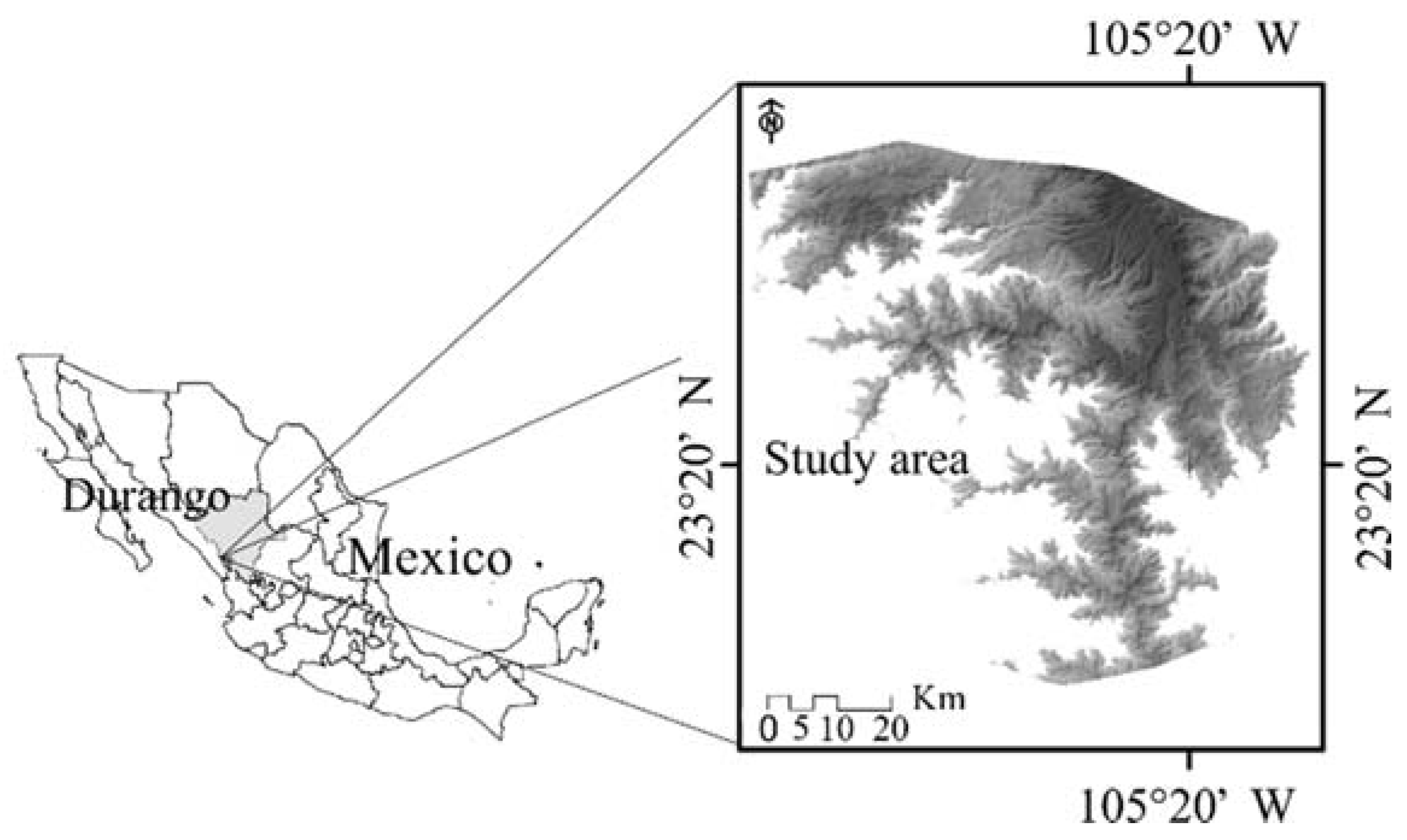

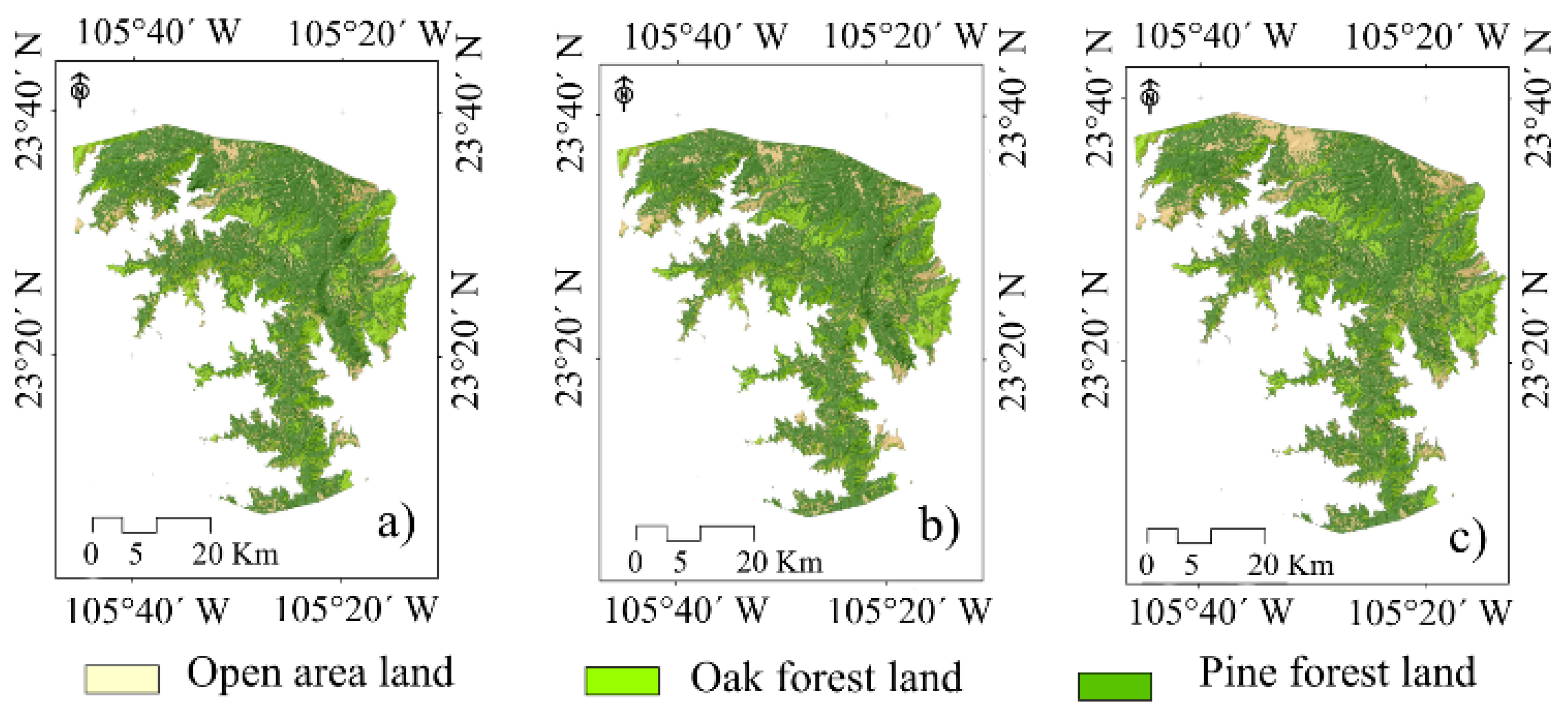
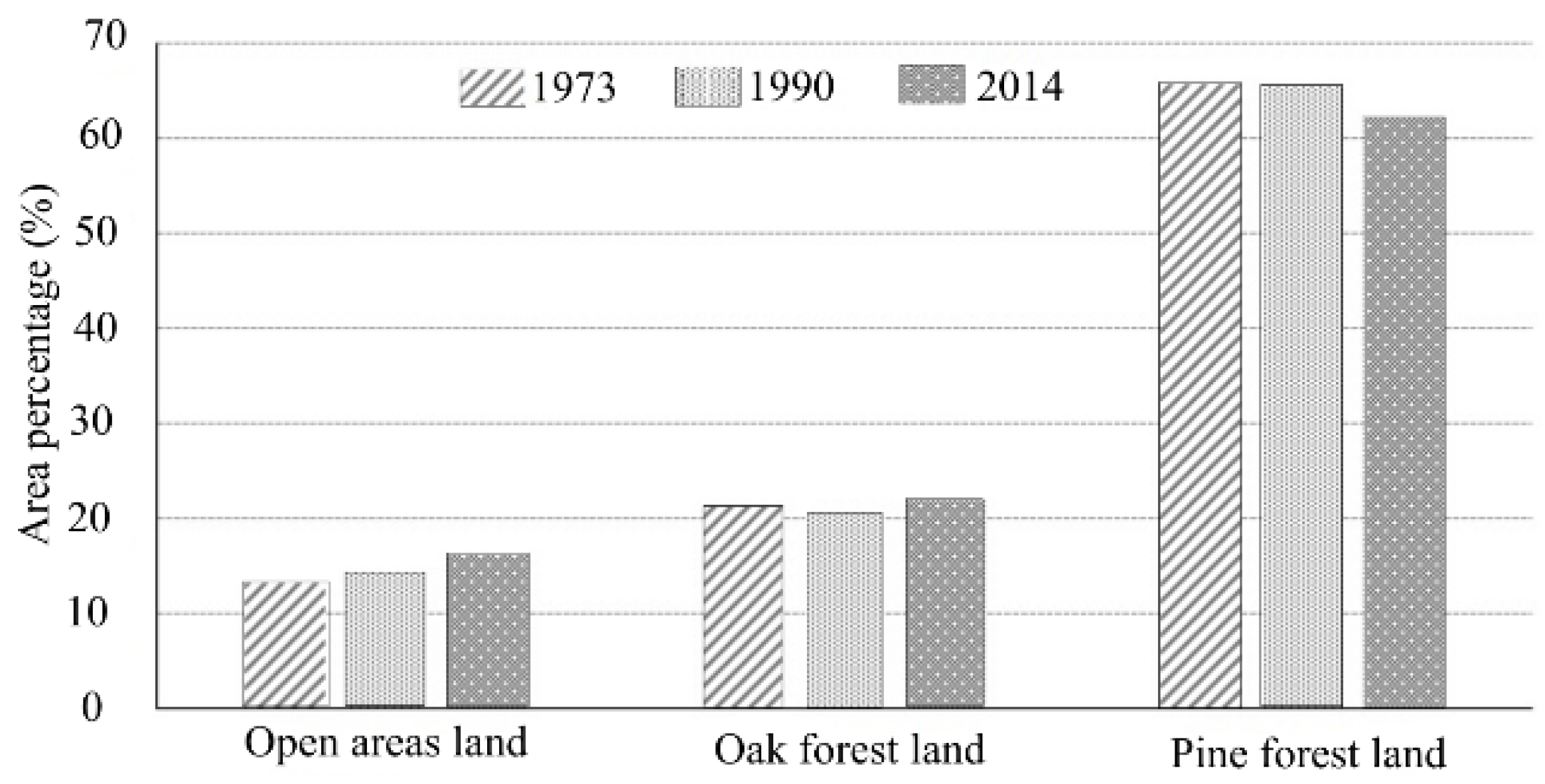
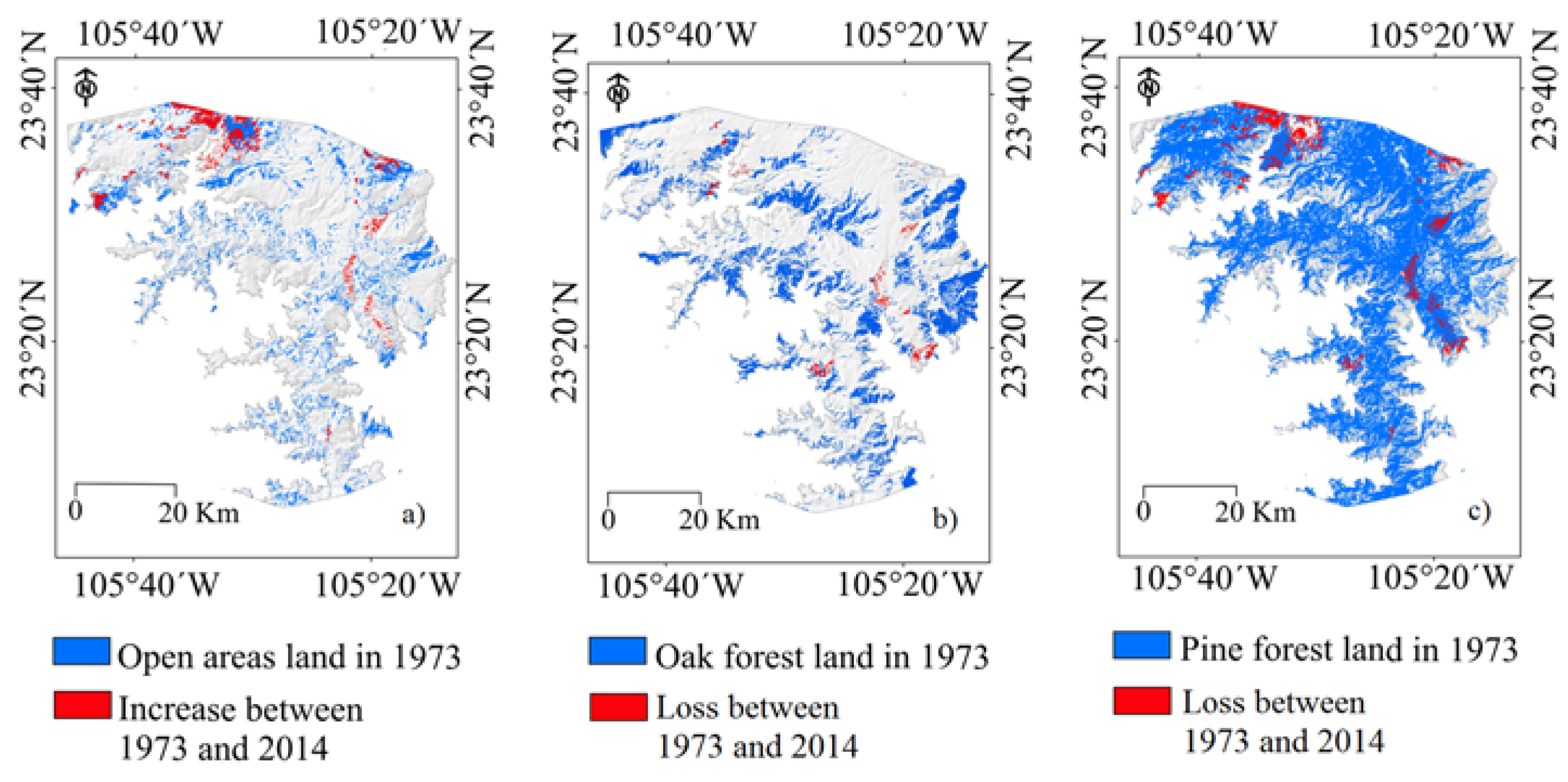
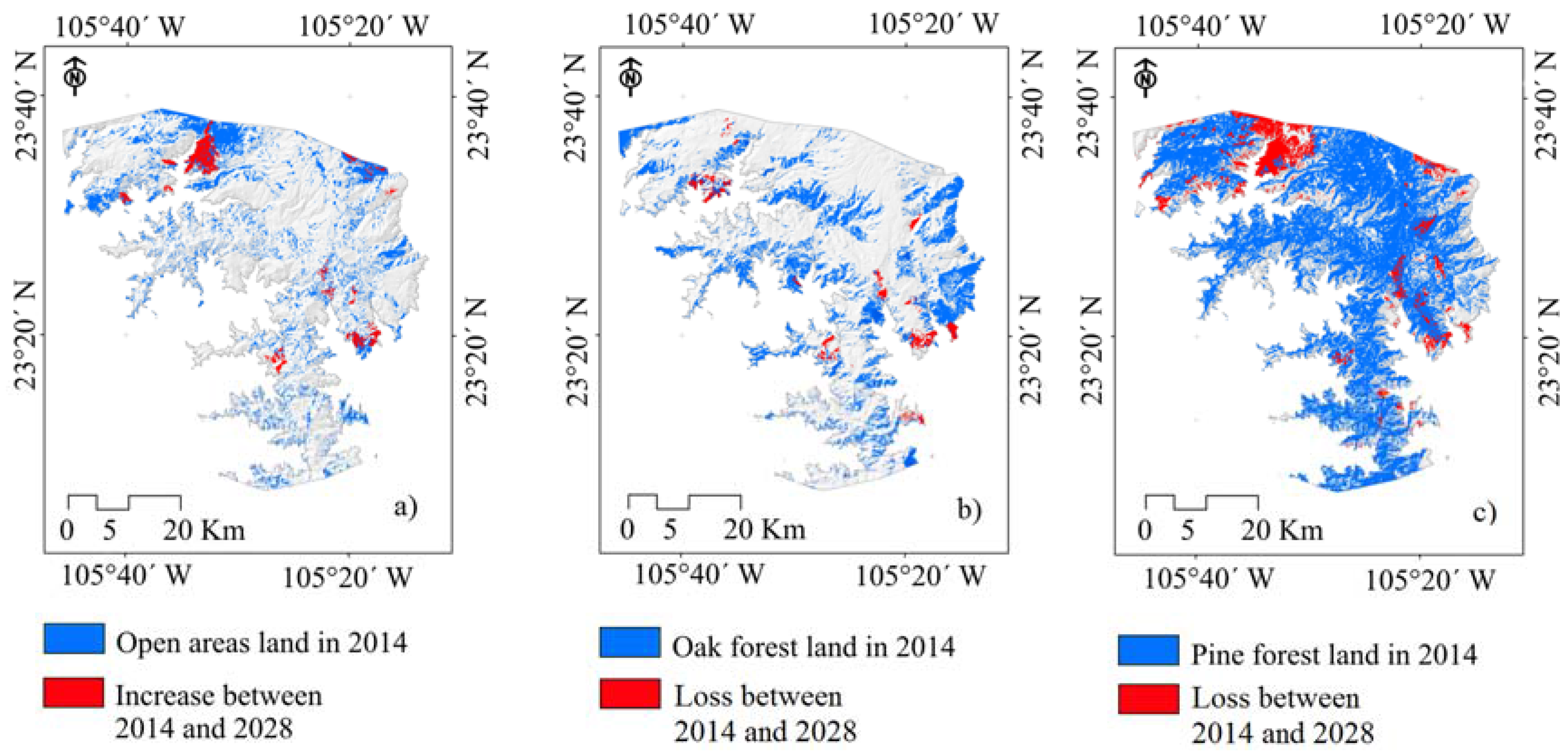
| Landsat MSS | Landsat TM | Landsat OLI8 | Band Name | Oa vs. Of | OA vs. Pf | Of vs. Pf |
|---|---|---|---|---|---|---|
| 1 | 1 | 2 | Blue | 1.33 | 1.39 | 0.88 |
| 2 | 2 | 3 | Green | 1.23 | 1.40 | 0.97 |
| 3 | 3 | 4 | Red | 1.11 | 1.38 | 1.13 |
| 4 | 4 | 5 | NIR | 1.45 | 1.46 | 1.65 |
| 5 | 6 | SWIR1 | 1.48 | 1.65 | 1.67 | |
| 7 | 7 | SWIR2 | 1.47 | 1.48 | 1.52 |
| Years/Classes | Classification Accuracy | |||
|---|---|---|---|---|
| Producer’s Accuracy (%) | User’s Accuracy (%) | Overall Accuracy (%) | Cohen´s Kappa | |
| 1973 | 93 | 0.91 | ||
| Open areas | 93 | 91 | ||
| Oak forest | 94 | 94 | ||
| Pine forest | 93 | 93 | ||
| 1990 | 94 | 0.92 | ||
| Open areas | 93 | 92 | ||
| Oak forest | 92 | 91 | ||
| Pine forest | 96 | 92 | ||
| 2014 | 92 | 0.90 | ||
| Open areas | 91 | 91 | ||
| Oak forest | 93 | 95 | ||
| Pine forest | 94 | 94 | ||
| Land Use | Area (in ha) and Percentages (%) | Changes (in ha) | ||||||
|---|---|---|---|---|---|---|---|---|
| 1973 | 1990 | 2014 | 1973–1990 | 1990–2014 | ||||
| Area | % | Area | % | Area | % | |||
| Open areas land | 18,304.57 | 13.20 | 19,742.13 | 14.23 | 22,363.47 | 16.12 | −1437.56 | −2621.34 |
| Oak Forest land | 29,327.24 | 21.14 | 28,418.46 | 20.49 | 30,397.13 | 21.91 | 908.78 | −1978.67 |
| Pine Forest land | 91,078.73 | 65.66 | 90,549.94 | 65.28 | 85,949.94 | 61.96 | 528.79 | 4600 |
| Land Use | Observed 14 | Predictor 14 | ||
|---|---|---|---|---|
| Area (ha) | Total Area (%) | Area (ha) | Total Area (%) | |
| Open areas | 22,363.44 | 16 | 21,988.89 | 16 |
| Oak forest | 30,397.13 | 22 | 30,989.21 | 22 |
| Pine forest | 85,949.94 | 62 | 85,732.41 | 62 |
| Pine Forest | Oak Forest | Open Areas | |
|---|---|---|---|
| 1973–1990 | |||
| Pine forest | 0.543 | 0.167 | 0.289 |
| Oak forest | 0.187 | 0.315 | 0.498 |
| Open areas | 0.276 | 0.204 | 0.519 |
| 1990–2014 | |||
| Pine forest | 0.422 | 0.208 | 0.369 |
| Oak forest | 0.308 | 0.294 | 0.398 |
| Open areas | 0.255 | 0.289 | 0.456 |
| 2014–2028 | |||
| Pine forest | 0.379 | 0.229 | 0.392 |
| Oak forest | 0.399 | 0.246 | 0.354 |
| Open areas | 0.252 | 0.294 | 0.453 |
© 2016 by the authors; licensee MDPI, Basel, Switzerland. This article is an open access article distributed under the terms and conditions of the Creative Commons by Attribution (CC-BY) license (http://creativecommons.org/licenses/by/4.0/).
Share and Cite
Vázquez-Quintero, G.; Solís-Moreno, R.; Pompa-García, M.; Villarreal-Guerrero, F.; Pinedo-Alvarez, C.; Pinedo-Alvarez, A. Detection and Projection of Forest Changes by Using the Markov Chain Model and Cellular Automata. Sustainability 2016, 8, 236. https://doi.org/10.3390/su8030236
Vázquez-Quintero G, Solís-Moreno R, Pompa-García M, Villarreal-Guerrero F, Pinedo-Alvarez C, Pinedo-Alvarez A. Detection and Projection of Forest Changes by Using the Markov Chain Model and Cellular Automata. Sustainability. 2016; 8(3):236. https://doi.org/10.3390/su8030236
Chicago/Turabian StyleVázquez-Quintero, Griselda, Raúl Solís-Moreno, Marín Pompa-García, Federico Villarreal-Guerrero, Carmelo Pinedo-Alvarez, and Alfredo Pinedo-Alvarez. 2016. "Detection and Projection of Forest Changes by Using the Markov Chain Model and Cellular Automata" Sustainability 8, no. 3: 236. https://doi.org/10.3390/su8030236







